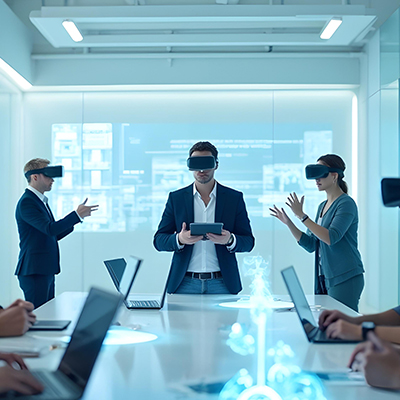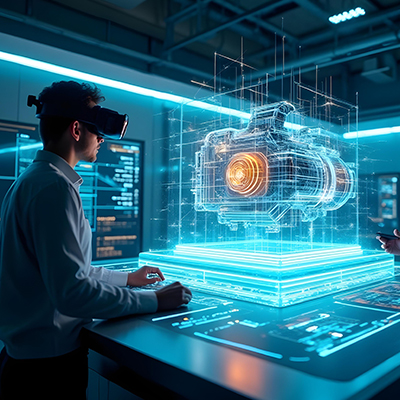We’ve all seen the advent of VR in a variety of industries, ranging from Aviation, Automotive, healthcare, and manufacturing to oil and Gas, and many more. Virtual Reality has now made its presence in the world of Defence and Military Training. It has established a significant role in modern military training programs across the globe.
The implementation of Virtual Reality in military training offers an immersive experience that is important for developing soldiers’ skills in high-pressure and dangerous situations. By donning VR headsets, military personnel can be transported to life-like environments where they can practice combat, medical procedures, or vehicle operations without the real-world consequences.
History of VR in Military Training
The use of Virtual Reality in military training is proof of innovation and technological evolution in combat preparation. The root of VR for military applications can be traced back to the 1980s, where VR technology was welcomed early on by the military. The introduction of pilot training was revolutionised by the first virtual flight simulator. Here are a few timelines:
- 1980s: The first documented virtual flight simulator is presented by the British Army to train Air Force pilots, marking the advent of VR in military circles. In the following years, VR technology progressed, and military simulators became increasingly sophisticated and diverse. The applications of VR branched out from flight simulation to include ground operations and tactical training.
- 1990s and 2000s: Expansion in VR applications included various training systems that simulated complex military environments and operations.
- The British Army, as part of its training methodology, began conducting trials with VR to enhance its Virtual Reality In-Land Training pilot, aiming to gather experimental data to support the Field Army’s Battle Craft Syllabus.
- In the modern context, governments are securing contracts to furnish a versatile training environment capable of simulating multiple terrains and operations for personnel around the globe, to train their military forces in the best way possible.
The historical trajectory of VR in military training mirrors the broader technological advancements, not only enhancing training realism but also preparedness for factual combat scenarios.
VR Training in Military Application
There has been a significant advancement in military training, offering immersive experiences that enhance soldier performance and tactical readiness. These state-of-the-art systems are tailored for different branches of the armed forces, with training modules designed around specific operational goals and instructional methodologies.
Air Force Pilot Training
VR for Air Force pilot training is changing the traditional cockpit learning environment. AR and VR programmes in military combat provide highly realistic flight simulations, where pilots can experience an airborne scene without the real risks and costs associated with the actual flight. VR also aids in taking frequent training sessions and the ability to simulate a wide range of conditions and simulations that are challenging.
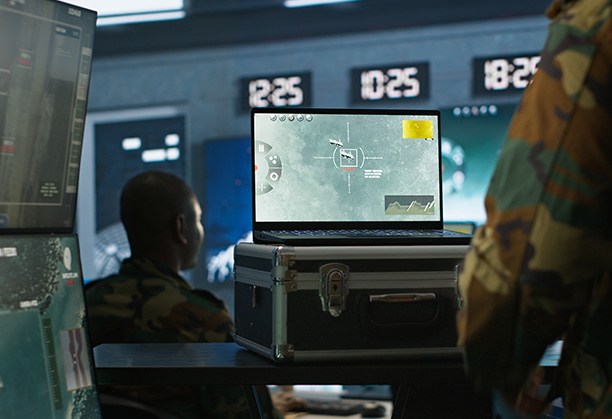
Battlefield Simulations
Battlefield simulations via VR prepare soldiers for real-world combat situations by providing a controlled and versatile environment. VR allows troops to train in detailed, simulated terrains that mirror potential combat zones, greatly improving their spatial awareness and decision-making under pressure.
Medical and First Aid Preparedness
In the realm of medical and first aid preparedness, VR is proving to be of great significance for the medics. These virtual environments offer the opportunity to practise life-saving procedures in trauma-based situations. This approach of training is enhancing the readiness of the military medical personnel, ensuring that they can respond with confidence and, more importantly, with precision in any situation.
Mission Rehearsal and Strategy
Talking about mission rehearsal and strategy, VR enables military units to visualise and rehearse operations before deployment. These immersive VR training simulations provide an interactive platform for practising various strategies, allowing troops to analyse and refine tactics in a dynamic, risk-free setting.
Through repeated rehearsals of mission-critical tasks and procedures, units can identify potential challenges and find solutions in advance of real-world execution.
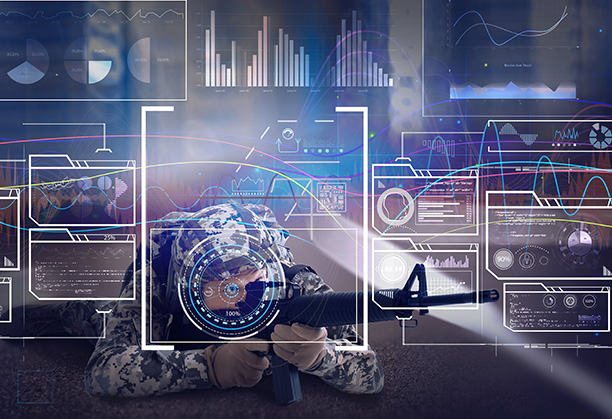
How The Military Sector Uses VR: Examples
VR offers the military a broad range of training options, including combat training and training for practicing procedures and operating critical equipment and weaponry. VR is also a vital training component for military personnel to learn and train for cyber defence.
Here are some examples:
For military exercises, the use of computer-generated forces widens the training options for the military and reduces both cost and risk. These synthetic training environments combine live training aspects with virtual elements.
The physical locations of individual participants pose no barrier to training. Within synthetic training environments, each participant trains in symmetry with others, as if they were taking part in exercises side-by-side on the battlefield.
Another use the military has for VR in training is for various specialized roles. These include explosive ordnance disposal and search, vehicle driving, vehicle mechanics, tank crews and gunner and artillery command.
All these roles require dedicated training in specific skills and procedures. VR offers convenience and efficiency, widening access to training and shortening training times.
VR supports basic training and discipline too, helping infantry soldiers practice tactics and formations, alongside weapons and combat training.
For airborne military personnel, there’s been a long-established use of flight simulators in training. However, VR offers far more versatility for giving pilots and other aircrew training in the fundamental skills they require.
VR can transform the classroom into a training cockpit, enabling personnel to learn and practice specialized skills without depending on either specialist simulation hardware or physical aircraft.
Sailors are using VR headsets to train with sophisticated navigation simulation programmes and practice dangerous naval manoeuvres. Software can replicate a ship’s bridges, port operations, and entire fleets, demanding weather conditions and naval combat scenarios.
Advantages of VR Training in the Military
Virtual Reality training offers the military innovative solutions to simulate real-world environments and scenarios. Through immersive experiences, it enhances skill sets while ensuring safety and reducing costs.
Enhanced Realism
VR is allowing military personnel to train in highly realistic battlefield scenarios. Many systems are replicating complex environments and situations with great precision, enabling soldiers to train for actual combat without the real-world risks.
Improved Safety
VR establishes safe training grounds. There is a significant reduction in risk for injury or even death as service members can learn to navigate dangerous situations within a controlled, virtual space.
Cost-Effectiveness
The use of VR also presents an opportunity for cost savings. Virtual environments mean less reliance on physical assets and locations, which are expensive to maintain and secure. Investing in VR leads to long-term savings.
Measurable Competence
VR training provides quantifiable evidence of a soldier’s skills and adaptability. It allows for the collection of data on performance, measuring and demonstrating competence in a variety of training modules, which can be essential for targeted improvements.

Challenges and Limitations
While VR provides dynamic training opportunities for the military, several challenges and limitations can affect its effectiveness and wide-scale implementation.
Technical Barriers
In military training, technical hurdles are very significant. Hardware issues, such as limited battery life and latency, can hamper the realism and immersion crucial for effective training. Creating training modules is complex and resource-intensive, often requiring extensive programming and 3D modelling. These systems must also be robust enough to withstand diverse and harsh operational environments faced by military personnel.
Physical and Psychological Adaptation
Prolonged use of VR equipment can cause side effects like motion sickness, eye strain, and discomfort among the trainees. Furthermore, there’s a risk that prolonged immersion might lead to a blurring of lines between virtual and real combat scenarios. This necessitates careful consideration of how VR is introduced and the frequency of its use, to prevent any negative psychological impact.
Integration with Traditional Training
Combining VR with conventional methods poses its challenges; finding the correct balance is crucial. Traditional training has been honed for decades and integrates nuances of real-world physics and social dynamics that VR hasn’t fully replicated. And more evidently there is a lot of scepticism amongst military trainers towards the effectiveness of VR means that it must demonstrate tangible benefits to be embraced as a complementary training tool.
Future Trends in Military Training with VR
Adoption of AI Technologies
Virtual Reality is being combined with Artificial Intelligence to create more dynamic and responsive training scenarios. For instance, soldiers can experience realistic and unpredictable combat situations where the AI adapts the mission and environment in real-time, providing a tailored training experience that improves decision-making skills under stress.
Multi-User Virtual Environments
Multi-user virtual environments are becoming a crucial trend in military training, allowing multiple participants to train simultaneously in a shared digital space. Teams can practice complex collaborative tasks, such as tactical manoeuvres or coordinated assaults, fostering unit cohesion and operational preparedness.
Hardware Advancements
Advancements in VR hardware are providing soldiers with more lightweight and comfortable headsets, coupled with better haptic feedback systems. These developments aim to enhance physical fidelity and reduce training-related fatigue, enabling longer and more frequent training sessions without compromising the quality or intensity of the experience.
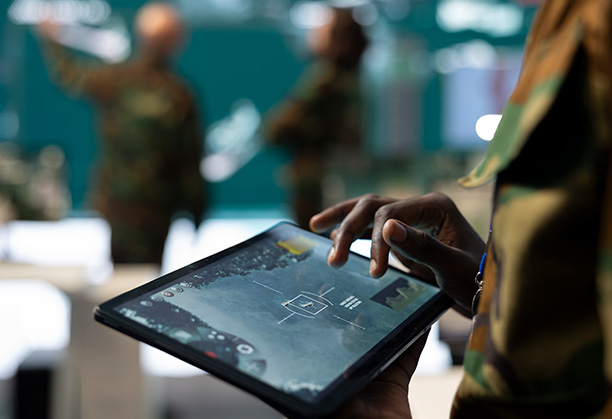
Ready for risk-free military training?
Juego neXR: Upgrading Military Readiness with Advanced VR
At Juego neXR, we develop high-fidelity Virtual Reality training environments tailored for modern military demands. Our VR solutions simulate diverse scenarios, from cockpit procedures and battlefield tactics to trauma care and mission rehearsals, offering realistic, repeatable, and immersive training without real-world risks.
By integrating dynamic interactivity, real-time analytics, and adaptable mission modules, our training systems boost operational readiness, decision-making accuracy, and unit coordination. Scalable and customizable, Juego neXR’s military-grade VR platforms are built to enhance competence, safety, and cost-efficiency, equipping personnel across forces to train smarter, respond faster, and operate with confidence in any situation.
Conclusion
Virtual Reality is no longer a futuristic concept but a mission-critical asset transforming military training worldwide. From its early use in flight simulation to its current role in immersive battlefield, medical, and mission rehearsal scenarios, VR has evolved into a powerful tool for enhancing preparedness and precision across all branches of defense. With its ability to simulate high-stakes environments safely, cost-effectively, and repeatedly, VR offers measurable improvements in skill acquisition, response times, and strategic thinking.
However, challenges like technical limitations, physical strain, and integration with traditional methods must be addressed for wider adoption. As AI, multi-user systems, and hardware continue to advance, VR will only become more indispensable. It is clear that the future of combat training lies in immersive technology, and VR will lead the charge in shaping smarter, safer, and more resilient armed forces.
Frequently Asked Questions
Emerging AI technologies are revolutionizing VR military training by making simulations more adaptive, intelligent, and responsive. AI-driven scenarios dynamically adjust based on a trainee’s performance, creating personalized challenges that improve decision-making under pressure.
VR training is considered significantly more effective than traditional military training methods due to its immersive, repeatable, and data-driven nature. It enables personnel to experience complex scenarios, such as combat, tactical maneuvers, or emergency medical response, with high levels of realism and without real-world risks. This method improves decision-making, increases knowledge retention, and allows for cost-effective, safe practice. Unlike static classroom sessions, VR training delivers dynamic, real-time feedback, better equipping trainees for the unpredictable nature of actual missions.
Military VR training programs typically utilize high-performance head-mounted displays (HMDs) like the Varjo XR series, Meta Quest, or HTC Vive, paired with motion tracking sensors, haptic feedback gear, and specialized input devices. On the software side, platforms such as Unreal Engine and Unity power realistic simulations, often integrated with AI for dynamic scenarios.
To minimize motion sickness and psychological stress in VR military training, developers implement optimized frame rates, ergonomic interactions, and gradual exposure techniques. Simulations are designed with customizable comfort settings and cognitive load-balancing to ensure immersive yet safe experiences. Additionally, debriefing modules and real-time monitoring help detect and manage trainee stress, ensuring the training remains effective, engaging, and aligned with both mental and physical readiness standards.
Revolutionize the future of business with Juego neXR
Table of Contents
- History of VR in Military Training
- VR Training in Military Application
- How The Military Sector Uses VR: Examples
- Advantages of VR Training in the Military
- Challenges and Limitations
- Future Trends in Military Training with VR
- Juego neXR: Upgrading Military Readiness with Advanced VR
- Conclusion
- Frequently Asked Questions
Related Posts
Share this Article:
Follow Us On:
© 2025 Juego neXR. All Rights Reserved.

